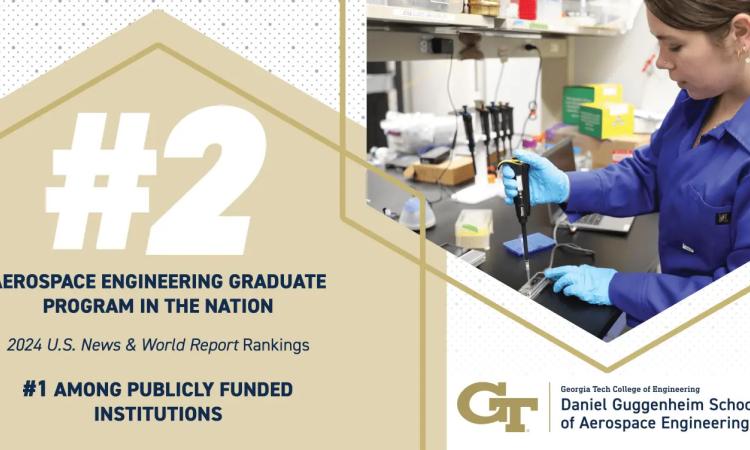The AE professor is working with an international group of scientists who are focused on near-Earth asteroid science and planetary defense.

Conceptual graphic showing ESA’s Hera spacecraft and its CubeSats in orbit around the Dimorphos moonlet. Photo courtesy of European Space Agency (ESA) Science Office.
Masatoshi (Toshi) Hirabayashi, an associate professor in the Daniel Guggenheim School of Aerospace Engineering, has been selected by NASA’s Hera Participating Scientist Program (HERA-PSP) to join the European Space Agency’s (ESA) Hera mission. Together, with an international consortium of 11 other scientists, Hirabayashi will perform a multi-faceted, detailed, post-impact study of NASA’s Double Asteroid Redirection Test (DART) mission. The DART mission was led by the Johns Hopkins University’s Applied Physics Laboratory.
The DART mission targeted the binary asteroid system where Dimorphos (the smaller secondary) orbits Didymos (the larger primary), to intentionally cause a spacecraft crash on Dimorphos. The collision, which occurred on September 26, 2022, was the first to demonstrate asteroid deflection by changing the asteroid's motion in space through kinetic impact. Astronomers monitored this event using ground- and space-based telescopes like the Hubble Telescope (HST). A recent Nature article, “Ejecta, From the DART-Produced Active Asteroid Dimorphos,” on which Hirabayashi is a co-author, documented HST’s detailed observations of the intense dust ejection generated by the impact.
The Hera mission, launching in October 2024, will analyze the post-DART impact conditions of Didymos and Dimorphos by performing remote sensing observations and employing two CubeSats from its parent spacecraft, Hera. Hera will arrive at the asteroid in 2026. The Planetary Science Journal article, “The ESA Hera Mission: Detailed Characterization of the DART Impact Outcome and the Binary Asteroid Didymos, highlights the project's developments.
Planetary defense is the primary reason for studying near-Earth asteroids (NEAs), particularly potentially hazardous objects (PHOs). While Didymos does not threaten the Earth, scientists want to prepare for the possibility that PHOs could hit the planet. Hera mission researchers can learn valuable information about the system's impact behavior.
Hirabayashi, a co-investigator for the DART mission, said, “I was thrilled to apply my experience in the DART mission, and I’m honored to now be part of the Hera mission.”
Specifically, Hirabayashi will analyze the mutual motion of the two asteroids in the Didymos binary system and provide detailed forecasts of the asteroids’ locations and velocities. During this investigation, he will use Georgia Tech’s high-performance computing system, Partnership for an Advanced Computing Environment (PACE). His results will also be used to quantify the system's post-DART impact behavior and develop new knowledge about planetary defense.
“Dinosaurs were completely wiped out by an asteroid about 66 million years ago. There are many possible threats, and we need the capability to defend the Earth properly,” Hirabayashi explained. “Such capability includes performing detailed potential risk assessment in a limited time span and, if necessary, deflecting and disrupting PHOs with proper measurements.”
Hirabayashi joined Georgia Tech in August 2023. His research concentration is in space operations, celestial mechanics, planetary science, and design and navigation. He works across the campus to explore lunar science at Georgia Tech’s Center for Lunar Environment and Volatile Exploration, one of the NASA/SSERVI nodes led by Thom Orlando in the College of Science’s School of Chemistry and Biochemistry.
In addition to his work on the Hera mission, Hirabayashi is also serving as interdisciplinary science lead for the Japanese Aerospace Exploration Agency’s Hayabusa2# mission, which explores planetary defense and material transport in the solar system. His current effort on this mission is assessing the best flyby timing and orientation to maximize the science return from the 2001 CC21 observations. Small bodies aren’t his only focus; he is also a co-investigator on the NASA/VIPER lunar rover mission.
(text and background only visible when logged in)
Related Stories:

New Multidisciplinary Initiative Marks Golden Age for Space Research
The Georgia Institute of Technology has a long history in space research and exploration, from educating astronauts to developing and controlling spacecraft that can travel across the solar system.

The AE School Leaps to No. 2 in the Nation for Graduate Aerospace Programs
The Daniel Guggenheim School of Aerospace Engineering (AE School) ranks No. 2 in the nation for aerospace engineering graduate programs, according to the U.S. News and World Report’s 2024-2025 rankings.

Georgia Tech to Strengthen Nation’s Faculty Development in Geospace Science
Georgia Tech’s Colleges of Engineering and Sciences have been chosen by the National Science Foundation (NSF) to hire a new faculty member focused on solar-terrestrial science and space weather research.
